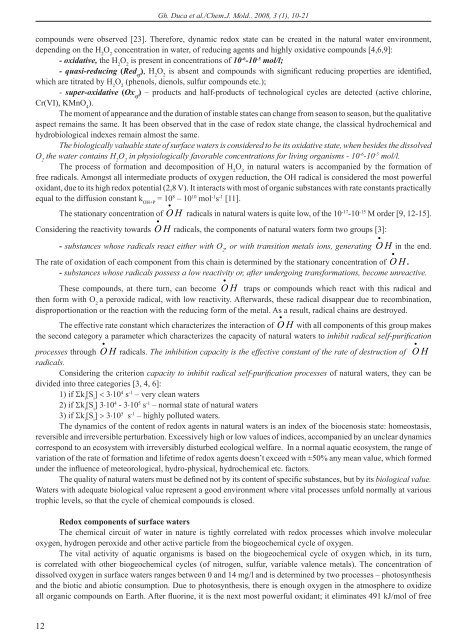chemistry journal of moldova
chemistry journal of moldova
chemistry journal of moldova
You also want an ePaper? Increase the reach of your titles
YUMPU automatically turns print PDFs into web optimized ePapers that Google loves.
Gh. Duca et al./Chem.J. Mold.. 2008, 3 (1), 10-21compounds were observed [23]. Therefore, dynamic redox state can be created in the natural water environment,depending on the H 2O 2concentration in water, <strong>of</strong> reducing agents and highly oxidative compounds [4,6,9]:- oxidative, the H 2O 2is present in concentrations <strong>of</strong> 10 -6 -10 -5 mol/l;- quasi-reducing (Red ef),H 2O 2is absent and compounds with significant reducing properties are identified,which are titrated by H 2O 2(phenols, dienols, sulfur compounds etc.);- super-oxidative (Ox ef) – products and half-products <strong>of</strong> technological cycles are detected (active chlorine,Cr(VI), KMnO 4).The moment <strong>of</strong> appearance and the duration <strong>of</strong> instable states can change from season to season, but the qualitativeaspect remains the same. It has been observed that in the case <strong>of</strong> redox state change, the classical hydrochemical andhydrobiological indexes remain almost the same.The biologically valuable state <strong>of</strong> surface waters is considered to be its oxidative state, when besides the dissolvedO 2the water contains H 2O 2in physiologically favorable concentrations for living organisms - 10 -6 -10 -5 mol/l.The process <strong>of</strong> formation and decomposition <strong>of</strong> H 2O 2in natural waters is accompanied by the formation <strong>of</strong>free radicals. Amongst all intermediate products <strong>of</strong> oxygen reduction, the OH radical is considered the most powerfuloxidant, due to its high redox potential (2,8 V). It interacts with most <strong>of</strong> organic substances with rate constants practicallyequal to the diffusion constant k OH+P= 10 8 – 10 10 mol -1 s -1 [11].The stationary concentration <strong>of</strong> O H radicals in natural waters is quite low, <strong>of</strong> the 10 -17 -10 -15 M order [9, 12-15].Considering the reactivity towards O H radicals, the components <strong>of</strong> natural waters form two groups [3]:- substances whose radicals react either with O 2, or with transition metals ions, generating O H in the end.The rate <strong>of</strong> oxidation <strong>of</strong> each component from this chain is determined by the stationary concentration <strong>of</strong> O H .- substances whose radicals possess a low reactivity or, after undergoing transformations, become unreactive.These compounds, at there turn, can become O H traps or compounds which react with this radical andthen form with O 2a peroxide radical, with low reactivity. Afterwards, these radical disappear due to recombination,disproportionation or the reaction with the reducing form <strong>of</strong> the metal. As a result, radical chains are destroyed.The effective rate constant which characterizes the interaction <strong>of</strong> O H with all components <strong>of</strong> this group makesthe second category a parameter which characterizes the capacity <strong>of</strong> natural waters to inhibit radical self-purifi cationO H radicals. The inhibition capacity is the effective constant <strong>of</strong> the rate <strong>of</strong> destruction <strong>of</strong> O Hprocesses throughradicals.Considering the criterion capacity to inhibit radical self-purifi cation processes <strong>of</strong> natural waters, they can bedivided into three categories [3, 4, 6]:1) if k i[S i] 310 4 s -1 – very clean waters2) if k i[S i] 310 4 - 310 5 s -1 – normal state <strong>of</strong> natural waters3) if k i[S i] 310 5 s -1 – highly polluted waters.The dynamics <strong>of</strong> the content <strong>of</strong> redox agents in natural waters is an index <strong>of</strong> the biocenosis state: homeostasis,reversible and irreversible perturbation. Excessively high or low values <strong>of</strong> indices, accompanied by an unclear dynamicscorrespond to an ecosystem with irreversibly disturbed ecological welfare. In a normal aquatic ecosystem, the range <strong>of</strong>variation <strong>of</strong> the rate <strong>of</strong> formation and lifetime <strong>of</strong> redox agents doesn’t exceed with ±50% any mean value, which formedunder the influence <strong>of</strong> meteorological, hydro-physical, hydrochemical etc. factors.The quality <strong>of</strong> natural waters must be defined not by its content <strong>of</strong> specific substances, but by its biological value.Waters with adequate biological value represent a good environment where vital processes unfold normally at varioustrophic levels, so that the cycle <strong>of</strong> chemical compounds is closed.Redox components <strong>of</strong> surface watersThe chemical circuit <strong>of</strong> water in nature is tightly correlated with redox processes which involve molecularoxygen, hydrogen peroxide and other active particle from the biogeochemical cycle <strong>of</strong> oxygen.The vital activity <strong>of</strong> aquatic organisms is based on the biogeochemical cycle <strong>of</strong> oxygen which, in its turn,is correlated with other biogeochemical cycles (<strong>of</strong> nitrogen, sulfur, variable valence metals). The concentration <strong>of</strong>dissolved oxygen in surface waters ranges between 0 and 14 mg/l and is determined by two processes – photosynthesisand the biotic and abiotic consumption. Due to photosynthesis, there is enough oxygen in the atmosphere to oxidizeall organic compounds on Earth. After fluorine, it is the next most powerful oxidant; it eliminates 491 kJ/mol <strong>of</strong> free12
















